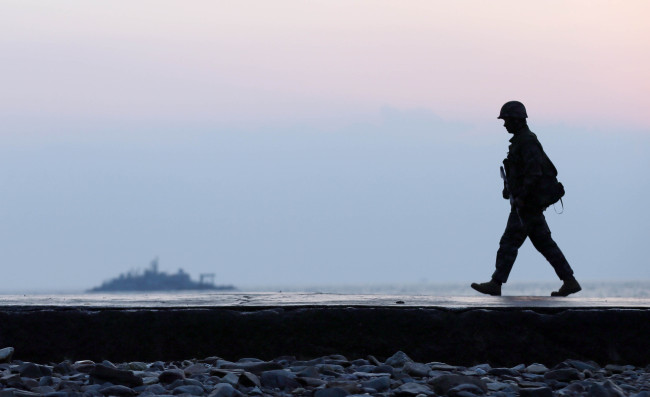4 years after island shelling, tensions still high on West Sea
By Korea HeraldPublished : Nov. 20, 2014 - 21:41
Four years after North Korea shelled Yeonpyeongdo Island, tensions remain high on the frontline island. Pyongyang has continued its menacing rhetoric and saber-rattling, keeping border troops in a constant state of alert.
To better defend the border islands after the Nov. 23 attack that killed two marines and two civilians, Seoul has established a new military command, and deployed new personnel and state-of-the-art weapons systems.
Despite Seoul’s military reinforcements, the North has continued its provocative moves including violating the Northern Limit Line, a de facto maritime border. Last month, a North Korean patrol ship crossed the NLL, triggering an exchange of fire between the two navies ― an incident that reaffirmed the need for stronger maritime defense.
Some nine months after the artillery attack, the South established a command dedicated to defending the northwestern border islands. The military also dispatched an additional 1,200 troops to the northern islands in charge of border defense.
To better defend the border islands after the Nov. 23 attack that killed two marines and two civilians, Seoul has established a new military command, and deployed new personnel and state-of-the-art weapons systems.
Despite Seoul’s military reinforcements, the North has continued its provocative moves including violating the Northern Limit Line, a de facto maritime border. Last month, a North Korean patrol ship crossed the NLL, triggering an exchange of fire between the two navies ― an incident that reaffirmed the need for stronger maritime defense.
Some nine months after the artillery attack, the South established a command dedicated to defending the northwestern border islands. The military also dispatched an additional 1,200 troops to the northern islands in charge of border defense.

In terms of military hardware, there has been a significant improvement. The number of K-9 self-propelled howitzers on the border islands including Baengnyeongdo has tripled. Other pieces of new equipment such as multiple rocket launchers, the Artillery Hunting Radar, Cobra attack helicopters and K-10 ammunition transport vehicles have also been deployed.
Also notable is the deployment last May of Israeli-made Spike missiles, which are capable of launching precision strikes on the North’s coastal artillery hidden in mountain caves and tunnels.
The military believes that the missiles, with a range of around 20 km, would help neutralize artillery forces within striking distance of its western coast. The communist state is known to have deployed some 1,000 artillery pieces in the coastal region including 76.2 mm-caliber coastal artillery guns and 122 mm multiple rocket launchers.
Seoul has also pushed for the deployment of tactical surveillance airships to the border islands to better monitor the security situation on the islands. The deployment is expected to begin early next year. The unmanned airship is to fly thousands of meters up to monitor areas near the border islands 24 hours a day.
To address concerns that North Korea’s special commandos could infiltrate the South Korean border islands aboard hovercrafts, the Marine Corps has made a basic plan to set up a unit equipped with hovercrafts and speed boats.
The areas near the border islands have become a tinderbox as the North has sought to nullify the sea border. Pyongyang argues that the border should be redrawn further south given that the borderline was unilaterally drawn by the U.S.-led U.N. Command after the 1950-53 Korean War.
The shelling of Yeonpyeongdo was the first attack on South Korean soil since the end of the Korean War. It has led the South Korean military to maintain a more proactive defense posture and prepare stronger antiprovocation measures.
By Song Sang-ho (sshluck@heraldcorp.com)
-
Articles by Korea Herald




![[Herald Interview] 'Amid aging population, Korea to invite more young professionals from overseas'](http://res.heraldm.com/phpwas/restmb_idxmake.php?idx=644&simg=/content/image/2024/04/24/20240424050844_0.jpg&u=20240424200058)















![[Today’s K-pop] Kep1er to disband after 2 1/2 years: report](http://res.heraldm.com/phpwas/restmb_idxmake.php?idx=642&simg=/content/image/2024/04/25/20240425050792_0.jpg&u=)